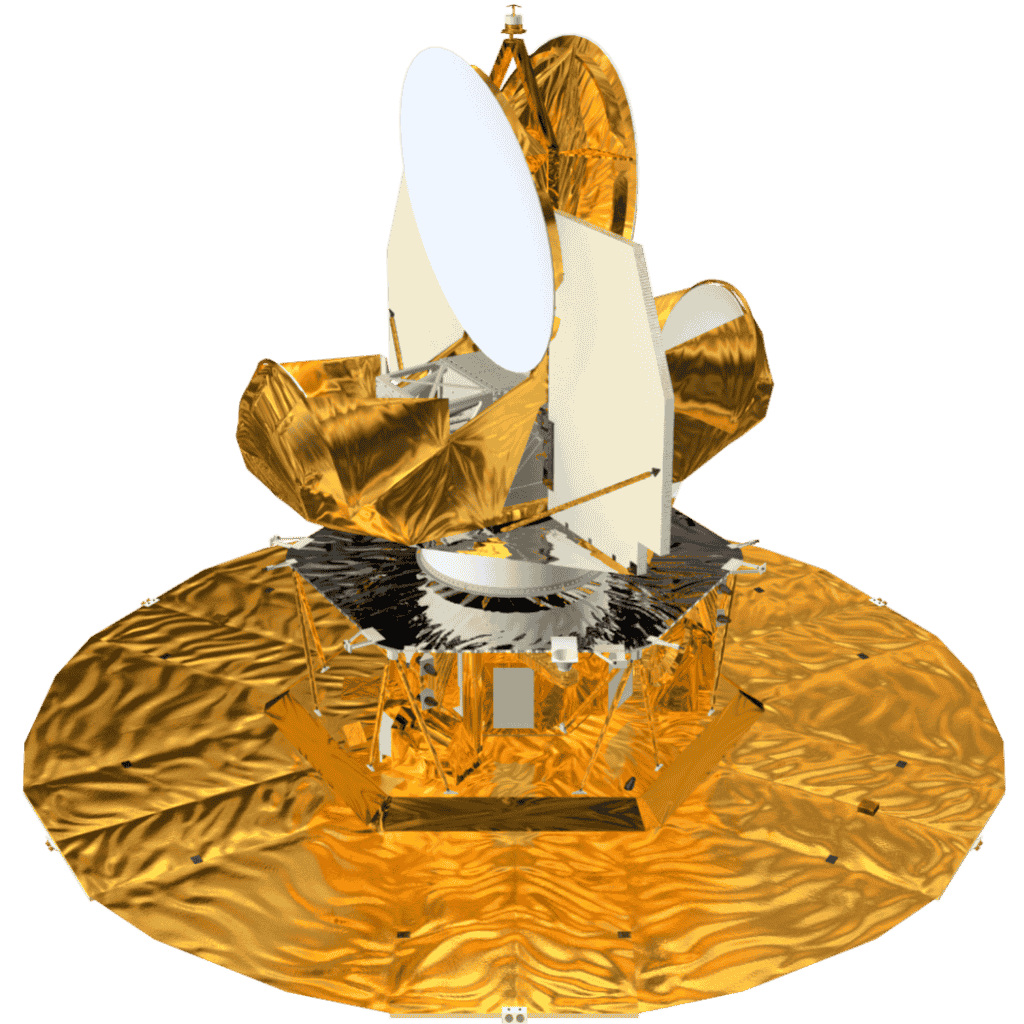Wilkinson Microwave Anisotropy Probe
Cosmic Background Mapper
Microwave telescope measuring the early universe

USPs
- Mapped Cosmic Microwave Background fluctuations
- Refined universe’s age and composition
- Paved the way for Planck Observatory
- Confirmed the universe’s flat geometry
- Provided first detailed full-sky CMB map
- Measured dark matter and dark energy proportions
- Released public data for global research
Major Milestones
- 2001-06-30: Launched aboard a Delta II rocket from Cape Canaveral, initiating its mission to map the cosmic microwave background (CMB) radiation.
- 2001-10-01: Reached the L2 Lagrangian point and began its first all-sky survey, collecting high-precision CMB data.
- 2003-02-11: Released its first-year data, providing the first detailed full-sky map of the CMB temperature fluctuations.
- 2006-03-16: Published three-year data, refining measurements of the universe's age, composition, and geometry with improved accuracy.
- 2008-02-25: Released five-year data, confirming the flatness of the universe and detecting subtle polarization signals.
- 2010-02-10: Concluded its nine-year mission, having completed all-sky surveys and exhausted its fuel supply.
- 2010-08-26: Transitioned to a heliocentric orbit, ending active operations but leaving a legacy of cosmological data.
- 2012-12-20: Released its final nine-year data set, offering the most precise measurements of the universe's early conditions to date.
- 2018-04: Data contributed to the Nobel Prize in Physics awarded to the WMAP team for insights into the universe's age and expansion.
- 2025-07-17: Data continues to influence cosmological research, supporting studies of the Big Bang and dark energy as of today.
Cosmic Portrait
WMAP: Measuring the Early Universe
Wilkinson Microwave Anisotropy Probe (WMAP), launched by NASA in 2001, was a landmark mission designed to map the faint glow of the Cosmic Microwave Background (CMB)—the remnant radiation from the Big Bang. By capturing minute temperature fluctuations across the entire sky, WMAP offered a detailed snapshot of the universe just 380,000 years after its birth. This data became the foundation of modern cosmology, transforming our understanding of the universe's age, shape, composition, and evolution.
- Scientific Contributions: WMAP provided the most accurate measurements of fundamental cosmological parameters at the time, including the universe’s age (13.8 billion years), the density of dark matter and dark energy, and the geometry of space. It confirmed that the universe is flat and composed primarily of dark components we cannot directly see.
- Orbit & Observation: The spacecraft was positioned at the second Sun–Earth Lagrange point (L2), a gravitationally stable spot about 1.5 million kilometers from Earth. This orbit allowed WMAP to conduct stable, long-duration microwave observations without interference from Earth’s heat or radio emissions.
- Instruments & Precision: Equipped with dual microwave radiometers operating across five frequency bands, WMAP captured tiny anisotropies—or temperature differences—within the CMB. These fluctuations held the imprints of density variations that later grew into galaxies and large-scale cosmic structures.
- Legacy & Recognition: The mission earned widespread acclaim, winning multiple awards including the Breakthrough Prize in Fundamental Physics. Its findings have been cited in thousands of scientific papers and helped validate the ΛCDM (Lambda Cold Dark Matter) model—the standard model of cosmology.
Impact on Modern Cosmology
WMAP’s results revolutionized the field by turning cosmology into a precision science. Prior to WMAP, estimates of the universe’s properties had large uncertainties. With WMAP, astronomers had clear, consistent data to base their models on. It effectively settled debates about the universe’s composition and expansion, proving that roughly 5% of the universe is normal matter, 27% is dark matter, and 68% is dark energy.
The mission also set the stage for even higher-resolution surveys. Its success directly influenced the European Space Agency’s Planck spacecraft, which launched in 2009 to further refine measurements of the CMB. Still, WMAP's clarity and simplicity made it one of the most important missions in the history of observational cosmology.
Why WMAP Still Matters
WMAP gave us a snapshot of the universe’s infancy, shaping our cosmic understanding and grounding theories of structure formation and cosmic inflation.
Decommissioned in 2010 after nine years of successful operation, WMAP’s impact endures. Its all-sky maps of the microwave background remain iconic representations of the universe’s earliest light. More than just a telescope, WMAP was a time machine—offering a view into the universe’s beginning and giving humanity its most complete cosmic blueprint at the time. It turned abstract theory into visual, measurable reality, and in doing so, redefined our place in the cosmos.
Fun Fact
WMAP confirmed the universe’s flat geometry!